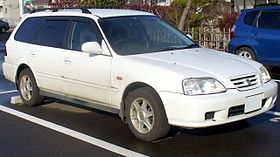Honda Orthia
| Honda Orthia/Honda Partner | |
|---|---|
 | |
| Overview | |
| Manufacturer | Honda |
| Also called | Honda Partner |
| Production | 1996–2002 (Orthia) 1996–2005 (Partner) |
| Assembly | Suzuka, Mie, Japan |
| Body and chassis | |
| Class | Compact |
| Body style | 5-door Station wagon |
| Layout | FF layout/AWD |
| Platform | Generation 6 Honda Civic |
| Related | Honda Civic |
| Powertrain | |
| Engine | 1.3 L D13 I4 SOHC 1.5 L D15 I4 SOHC 1.6 L D16 I4 SOHC 1.8 L B18B I4 DOHC 2.0 L B20B I4 DOHC |
| Transmission | 5-speed manual 4-speed automatic PROSMATEC Type II |
| Dimensions | |
| Wheelbase | 2,620 mm (103.1 in) |
| Length | 4,570 mm (179.9 in)–4,635 mm (182.5 in) |
| Width | 1,695 mm (66.7 in) |
| Height | 1,485 mm (58.5 in)–1,500 mm (59.1 in) |
| Curb weight | 1,170 kg (2,579 lb)–1,300 kg (2,866 lb) |
| Chronology | |
| Predecessor | Honda Civic Shuttle |
| Successor | Honda Airwave |

The Honda Orthia was a compact wagon manufactured by Honda exclusively for Japan, based on the sixth generation Honda Civic. Introduced in February 1996 as what Honda called a "Sport Utility Wagon", it was available as 2WD or 4WD. It was powered by an 1834 cc (B18B) or 1972 cc (B20B) straight-4 engine. It was sold at Honda Primo dealerships. The name "orthia", a variation of the Greek word orithyia, comes from Artemis Orthia in Greek mythology.
The following models were available at launch (with a choice of P (Primo) or V (Verno) equipment grade):
- 1.8GX FF 5MT or 4AT,
- 2.0GX FF 5MT or 4AT; 4WD 5MT or 4AT,
- 2.0GX-S 4WD 4AT
In January 1998, an additional model, the 2.0GX-S Aero, was introduced.
A facelift in June 1999 saw only the 2.0 engine available and the models were B, M, S (4AT only), M4 and L4 (4AT only); the last two being the 4WD versions. Production of Orthia ceased in 2002 (only 136 vehicles were produced that year[citation needed]) while its sibling, the Partner, continued. The Orthia was replaced by the Honda Airwave.
A basic commercial version, the Honda Partner (ホンダ・パートナー, honda paatonaa) (1.3, 1.5 and 1.6 engines), was introduced on March 15, 1996. The 1.6L Partner was Honda's first Low Emission Vehicle and came with a double wishbone suspension. ABS was installed in January 1998, and the vehicle was brought into year 2000 emissions compliance along with a driver-side airbag as standard equipment.
